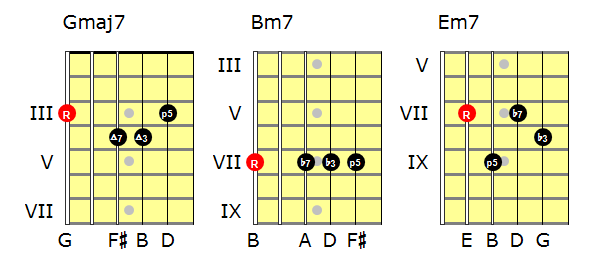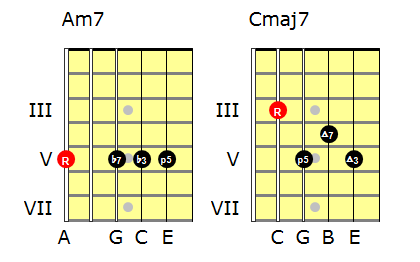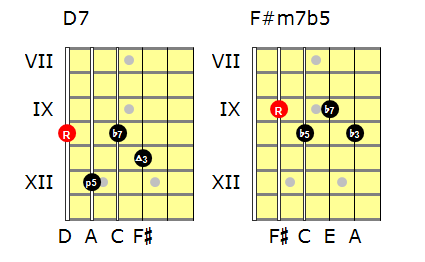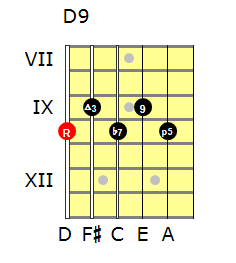Before we get started let’s define what chord families are not. When I refer to chord families I don’t mean simply grouping chords into major, minor or diminished categories. Neither do I mean grouping chords based on a common root note. In this post the term chord families is used to group chords with similar properties in a more interesting and useful way. In fact, it’s a categorisation of the harmonic function of chords.
You probably already know that within the major scale there are 7 possible diatonic chords; some major in tonality, some minor and a single diminished chord. In jazz terms – by including the 7th in each chord – we end up with major 7, minor 7 and minor 7b5 chords. The harmonised major scale then looks like this:
- maj7 (I)
- min7 (ii)
- min7 (iii)
- maj7 (IV)
- dom7 (V)
- min7 (vi)
- min7b5 (vii)
So far so good.
By looking at the tonality of the chords it is possible to group the chords into families – or harmonic functions – that share similar harmonic properties. Why would we want to do this? Well, that will become clearer later on but in general we can use the chord families to generalise an approach to how we combine and move between chords or implement chord substitutions.
Tonic
The first chord family is the Tonic chord family. The chords that make up this family are rooted off the following degrees of the major scale:
- 1st (Tonic)
- 3rd (Mediant)
- 6th (Submediant)
This gives us:
- Maj7 (I)
- min7 (iii)
- min7 (vi)
Note that none of these chords include a tritone (b5 or #4) interval between any of their notes. The other feature of these chords is that none of them contain the 4th degree of the major scale.
The chords in the Tonic family tend to express the tonal foundation of the piece. They are therefore often used to identify the start or end of a section of music or even a whole piece.
Example in G major
As an example in G major the Tonic family contains Gmaj7, Bm7 and Em7.

Note that the chords share a lot of notes. All the notes in the 3 chords come from the following set:
A – B – D – E – F# – G
Gmaj7 and Bm7 share the B, D and F#, 3 of the 4 notes in each chord. Gmaj7 and Em7 share the B, D and G, again 3 of the 4 notes. In fact, the D and the B are in all 3 chords.
Because the Tonic chords have so much in common they have a similar sound.
Subdominant
The second chord family is the Subdominant chord family. The chords that make up this family are rooted off the following degrees of the major scale:
- 2nd (Supertonic)
- 4th (Subdominant)
This gives us:
- min7 (ii)
- Maj7 (IV)
Unlike Tonic chords, chords of the Subdominant family do contain the 4th degree of the major scale.
The chords in this family can be used to express movement away from the tonal foundation of the key – the Tonic family – and towards the Dominant family.
Example in G major
As an example in G major the Subdominant family contains Am7 and Cmaj7.

Again, you can see that the cords in the Subdominant family share a lot of notes. In this case the C, E and G which is 3 of the 4 notes.
Dominant
The third chord family is the Dominant chord family. The chords that make up this family are rooted off the following degrees of the major scale:
- 5th (Dominant)
- 7th (Leading Tone)
This gives us:
- Dom7 (V)
- min7b5 (vii)
The interesting thing about the chords of the Dominant family is that they each contain a tritone (a b5 interval). In the case of the min7b5 that’s pretty obvious – it’s got a b5. However, the Dom7 has a tritone between its major 3rd (3) and minor 7th (b7).
The presence of a tritone introduces harmonic tension and chords of the Subdominant family want to resolve to chords of the Tonic family.
The minor 7b5 is rooted off the Leading Tone – the 7th note of the major scale – so it naturally wants to resolve to the Tonic. But if you look at the dominant 7th its major 3rd is also the Leading Tone so the chord contains the same harmonic tension that wants to resolve to the Tonic.
Example in G major
As an example in G major the Dominant family contains D7 and F#m7b5.

Again, the cords in the Dominant family share notes. In this case the C and F#. You can also see that each chord contains the F# – the Leading Note – that wants to be resolved to the Tonic (G).
Note something else here too. If you add a D in the bass to the F#m7b5 and treat that as the root note you end up with another dominant chord; it contains the R, 3, 5 and b7. It also has the 9 so it’s actually a D9. This demonstrates the close relationship between m7b5 chords and dominant chords.

Motion between chord families
So, what does this mean?
Basically, we can create strong forward motion in music by moving between chords of different families. Think of the classic ii-V-I progression; each chord comes from a different chord family. In fact, in the case of ii-V-I, it’s Subdominant to Dominant to Tonic, following the general characteristics outlined above for each chord family.
If you take a look at some of the more common chord progressions you will find they tend to follow the same flow between chords of different chord families. Here are some examples.
| Progression | Progression by Chord Family |
| I – IV – V | Tonic – Subdominant – Dominant |
| I – ii – V | Tonic – Subdominant – Dominant |
| I – vi – ii – V | Tonic – Tonic – Subdominant – Dominant |
| I – iii – vi – ii – V | Tonic – Tonic – Tonic – Subdominant – Dominant |
| ii – V – I | Subdominant – Dominant – Tonic |
You’ll see that the chords tend to flow from family to family according to the rules and characteristics we discussed above. In general, the flow is in the order of Tonic – Subdominant – Dominant (and back to Tonic to start the cycle again). This doesn’t mean you have to start on a Tonic chord, just that the flow is generally in that order.
Summary
Here’s a table containing a summary of chord families.
| Family | Chord roots | Description |
| Tonic | 1st (Tonic) 3rd (Mediant) 6th (Submediant) |
No tritones. Chords don’t contain the 4th degree. Express the tonal foundation of the piece. Identify the start or end of a section. |
| Subdominant | 2nd (Supertonic) 4th (Subdominant) |
Do contain the 4th degree. Used to express movement away from the tonal foundation and towards the Dominant family. |
| Dominant | 5th (Dominant) 7th (Leading Tone) |
Contain a tritone (b5). Want to resolve to chords of the Tonic family. |
Further Reading
For a detailed analysis of harmonic functions try this post from the Open Music Theory site.

This gives us:
Typo, I think you meant (iii), not (ii)
Ah! Good catch. That should be corrected now. Many thanks James.